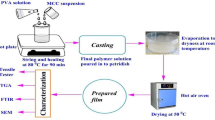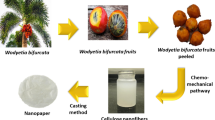Abstract
The production of light-weight polyester fabrics from a polyester/cotton blended fabric, by means of the enzymatic removal of the cellulosic part of the material, was investigated. The removal of cotton from the blended fabric yielded more than 80% of insoluble microfibrillar material by the combined action of high beating effects and cellulase hydrolysis.Other major features of this enzymatic process for converting cotton fibers into microfibrillar material are bath ratio, enzyme dosage and treatment time.
Similar content being viewed by others
References
Aizenshtein E.M. (2004). World chemical fiber and thread production in 2003. Fiber Chem. 36: 467–482
Andreaus J., Azevedo H., Cavaco-Paulo A. (1999). Effects of temperature on the cellulose binding ability of cellulase enzymes. J. Mol. Catal. B: Enzyme 7: 233–239
Béguin P. (1990). Molecular biology of cellulose degradation. Annu. Ver. Microbiol. 44:219–248
Boisset C., Pétrequin C., Chanzy H., Henrissat B., Schülein M. (2001). Optimized mixtures of recombinant Humicola insolens cellulases for the biodegradation of crystalline cellulose. Biotechnol. Bioeng. 72: 339–345
Bradford M. (1976). A rapid and sensitive method for the quantification of microgram quantities of protein utilizing the principle of protein–dye binding. Anal. Biochem. 72: 248–254
Camacho F., González-Tello E., Jurado E., Robles A.(1996). Microcrystalline cellulose hydrolysis with concentrated sulphuric acid. J. Chem. Technol. Biotechnol. 67: 350–356
Cavaco-Paulo A. (1998). Mechanism of cellulase action in textile processes. Carbohydr. Polym. 37: 273–277
Cavaco-Paulo A., Almeida L., Bishop D. (1996). Effects of agitation and endoglucanase pre-treatment on the hydrolysis of cotton fabrics by a total cellulase. Text. Res. J. 66: 287–294
Clarke AJ. (1997). Biodegradation of cellulose: enzymology and biotechnology. Technomic, Lancaster PA
Cortez J.M., Ellis J., Bishop D.P. (2001). Cellulase finishing of woven, cotton fabrics in jet and winch machines. J. Biotechnol. 89: 239–245
Foreman P., Brown D., Dankmeyer L., Dean R., Diener S., Dunn-Coleman N., Goedegebuur F., Houfek T., England G., Kelley A., Meerman H., Mitchell T., Mitchinson C., Olivares H., Teunissen P., Yao J., Ward M. (2003). Transcriptional regulation of biomass-degrading enzymes in the filamentous fungus Trichoderma reesei. J. Biol. Chem. 278: 31988–31997
Guimarães B.G., Souchon H., Lytle B.L., Wu J.H.D., Alzari P.M. (2002). The structure and catalytic mechanism of cellobiohydrolases CelS, the major enzymatic component of the Clostridium thermocellum cellulosome. J. Mol. Biol. 230: 587–596
Jeoh T., Wilson D.B., Walker L.P. (2002). Cooperative and competitive binding in synergistic mixtures of Thermobifida fuscas cellulases Cel5A, Cel5B and Cel9A. Biotechnol. Prog. 18: 760–769
Mansfield S.D., Mooney C., Saddler J.N. (1999). Substrate and enzyme characteristics that limit cellulose hydrolysis. Biotechnol. Prog. 15: 804–816
Mäntylä A., Paloheimo M., Suominen P., (1998). Industrial mutants and recombinant strains of Trichoderma reesei. In: Harman G.E., Kubicek C.P. (eds) Trichoderma and Gliocladium, vol. 2. Taylor & Francis, London, pp. 291–309
Miettinen-Oinonen A., Paloheimo M., Lantto R., Suominen P. (2005). Enhanced production of cellobiohydrolases in Trichoderma reesei and evaluation of the new preparations in biofinishing of cotton. J. Biotechnol. 116: 305–317
Morgado J., Cavaco-Paulo A., Rousselle M.-A. (2000). Enzymatic treatment of Lyocell – clarification of deppiling mechanisms. Text. Res. J. 70: 696–699
Murashima K., Kosugi A., Doi R.H. (2002). Synergistic effects on crystalline cellulose degradation between cellulosomal cellulases from Clostridium cellulovorans. J. Bacteriol. 184: 5088–5095
Parsiegla G., Juy M., Reverbel L.C., Tardif C., Bélaich J.-P., Driguez H., Haser R. (1998). The crystal structure of processive endocellulase CelF of Clostridium cellulolyticum in complex with a thiooligosaccharide inhibitor at 20 A resolution. EMBO J. 17: 5551–5562
Penttilä M., (1998). Heterologous protein production in Trichoderma. In: Harman G.E., Kubicek C.P. (eds) Trichoderma and Gliocladium, vol. 2. Taylor & Francis, London, pp 365–382
Teeri T.T. (1997). Crystalline cellulose degradation: new insight into the function of cellobiohydrolases. Trends Biotechnol 15: 160–167
Tomme P., Warren R.A.J., Gilkes N.R. (1995). Cellulose hydrolysis by bacteria and fungi. Adv. Microb. Physiol. 37: 1–81
Author information
Authors and Affiliations
Corresponding author
Rights and permissions
About this article
Cite this article
Vasconcelos, A., Cavaco-Paulo, A. Enzymatic removal of cellulose from cotton/polyester fabric blends. Cellulose 13, 611–618 (2006). https://doi.org/10.1007/s10570-006-9063-2
Received:
Accepted:
Published:
Issue Date:
DOI: https://doi.org/10.1007/s10570-006-9063-2




